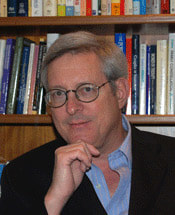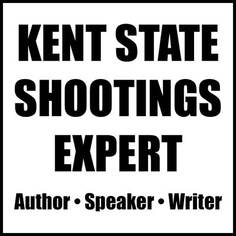|
After I wrote the article about Stuart Allen, saying he detected a second and actual order to fire (which no newspaper in the country, including the Daily Kent Stater, covered) I heard from John Mangels, the Plain Dealer's science reporter. Mangels was the author of the three front-page stories that gave rise to the calls for a new investigation. That made him, as far as I am concerned, one of the unsung heroes of May 4. He reminded me that he interviewed Captain Ron Snyder for his initial story on May 9, 2010, and that Snyder (like Captain Martin and Sergeant Matthew McManus) challenged Allen's finding, claiming the preliminary order did not sound like an order someone in the military would give.
That had completely slipped my mind, probably because Ron "Cynanide" Snyder is not a source I ever gave much credence to. That is partially because Snyder was not even among the squad that opened fire that day and thus, was not in a position to know what really happened. His unit was on the other side of Taylor Hall when the shootings broke, and the building completely blocked his view. Also, I still cannot get out of my head something said about Snyder after he originally told author James Michener, the Akron Beacon Journal, and a state grand jury that he confiscated a gun and brass knuckles off the body of slain student Jeffrey Miller. Snyder subsequently admitted he fabricated this claim because he wanted to make the victims seem dangerous, thereby making the shootings look justifiable. Snyder decided to come clean after the Justice Department started investigating this claim. I saw papers on Judge Frank Battisti's law clerk's desk suggesting the Justice Department seriously considered indicting him for perjury before the original state grand jury. I once had a beer with the editor who directed the ABJ's coverage, and he told me: "If he told me his name was Snyder, I still would not believe him." Snyder, incidentally, once guest lectured to my class in criminal justice at Kent in the spring of 1973. In a case of bad timing, I only found out about it afterwards. I had played hooky that day . . . Another interesting but not exactly earthshattering item: A few weeks ago I received a letter from the Justice Department's Freedom of Information office in response to an appeal I made for any records showing that the Justice Department did anything when they were asked to reinvestigate the new evidence. The Department's appeals division ignored part of my request and claimed they had no records of any such requests for reinvestigation, even though Justice Department officials met with a wounded survivor, other former students, and their attorney in May 2010. The Department's position--that there never were any calls for reinvestigation, and that no records ever were kept of this meeting, sounded highly suspicious to me. If the Department was telling the truth, that meant that all the public calls for a new investigation were made for publicity purposes, not to get the investigation. The wounded survivor I mentioned used to repeatedly get headlines by calling for additional investigations. Should not have he have made a formal request in writing? And did he and the others already understand that the only statute that still could be used to prosecute the Guardsmen--homicide--is a state, not a federal crime? The truth is there was not anything the Justice Department could have done anyway, save perhaps ask the National Academy of Sciences to review the tape and provide a second opinion . . . Finally, I recently received an e-mail out of the blue from a former Colorado National Guardsmen. He sharhed that that, after watching a film about riot control just before the campuses blew up in May 1970, "we all agreed that, if faced with a riot, we would set our M-16s on rock & roll (full automatic) and mow the protestors down." This dovetailed very closely with a story that a then Kent State student, told the FBI a year after the tragedy. The student claimed he hitched a ride from someone who told him he was one of the soldiers that fired at the students and that the troops had discussed shooting students before it actually happened. Unfortunately, the hitchhiker was only able to provide the FBI with very sketchy information about the soldier and his car. The FBI never was able to identify him, and that line of inquiry was never pursued by the attorneys who filed wrongful death claims against the Guardsmen. The letter at least reminded me of the mindset of many of those upholding the law--as well as many in the general public--in May 1970. The war and Kent State divided the country more deeply than any other time since the Civil War. As Time magazine reported even a year before the shootings , there was a sentiment throughout the country that when it came to the antiwar demonstrations, "enough is enough."
1 Comment
There has been another major bombshell in the Kent State shooting case--this one following a year of startling disclosures about what apparently happened during at the university during an anti-Vietnam War protest on May 4, 1970.
Last year, less than a week after the 40th anniversary, Cleveland's Plain Dealer reported that two nationally renowned audio forensics experts studied a tape of the shootings and concluded there was an order "prepare to fire" issued just six seconds before the troops actually did. Five months later, the paper reported that one of the experts, Stuart Allen, had continued to study the tape on his own, focusing on a commotion he heard 70 seconds before Ohio National Guardsmen killed the four students. Allen further concluded that four additional shots were fired by Terry Norman, a part-time Kent State student and later a Washington, D.C. police SWAT officer, who was carrying a concealed .38 caliber pistol. Given that both Norman and the FBI long denied the gun had been fired, and that after initial denials Norman was ultimately discovered to have been an undercover photographer working for both the FBI and the campus police, questions were raised about whether Norman was just a loose cannon or part of the FBI's infamous COINTELPRO operation designed to "disrupt and destroy" radicals on the New Left. Now, Allen reports that by isolating even more sounds on the tape, he has been able to make out a second and actual order to shoot the students. Allen says he can make out these words: "Squad, fire." Allen's findings, of course, contradict every public statement Guard officials made and the sworn testimony of at least a dozen soldiers. At the 1975 wrongful death and injury trial every Guardsman at the scene from the senior officers to the lowest-ranking privates insisted every "shooter" individually made the decision to fire in self-defense, without receiving any orders from commanding officers. Allen suspects the killings may have been the culmination of "a perfect storm" of multiple coinciding events. Given all the other contributing causes, he is probably right. However, I personally doubt that the bullets Norman allegedly fired could have precipitated the Guards' volley. Even if Norman fired four times, as Allen reports, the troops did not return fire in his direction (which would have directly behind them and off to their side) . Instead, they fired directly into a crowd of protestors off to their distant right. In fact, all but one of the 77 soldiers who faced the students seemed oblivious to Norman's presence on Blanket Hill. A man with the gun was not even mentioned in virtually all of the troops' after-action reports or in their statements to the FBI. Moreover, none of the troops fired their weapons until after 70 seconds had passed. Perhaps most telling, no soldier tried to pin the blame on him at the 1975 wrongful death and injury trial, even though Norman would have made a perfect scapegoat. Still, Norman's behavior on May 4 remains highly suspect. In addition to the claims that he fired his gun, there was disturbing testimony--confirmed by Norman himself--that he positioned himself in between the protestors and the Guardsmen minutes before the shooting broke out and that he threw rocks at the students. Norman swore under oath that he only threw two or three rocks, but the student involved in an altercation with him, Tom Masterson, thought the number was closer to "half dozen, a dozen." One could reasonably conclude that Norman behaved almost as if he wanted to provoke an incident between the students and the Guard. All of this begs the question: what can or should be done with this information? More than four decades have passed since the killings and with the exception of a few relatives of those killed, there are not that many people who want to see another prosecution of the former Guardsmen. The state of Ohio has already refused to consider further action and the Justice Department has for 16 months simply ignored the pleas of the next-of-kin who seem to believe the truth will somehow magically reveal itself if another federal grand jury investigation was held. The case remains where it has always been: in limbo. We are no closer to realizing anything resembling a final resolution. To date, no Guardsman has said a word publicly about Allen's conclusions. |
AuthorThis blog is written by William A. Gordon, a Kent State alumnus and the author of "Four Dead in Ohio" and three other books. It offers commentary on the still unfolding developments in the Kent State shooting case. Archives
March 2020
Categories
All
|
|
Kent State Shooting Expert
William A. Gordon Email: [email protected] Website: www.KentStateShootingsExpert.com |

 RSS Feed
RSS Feed
